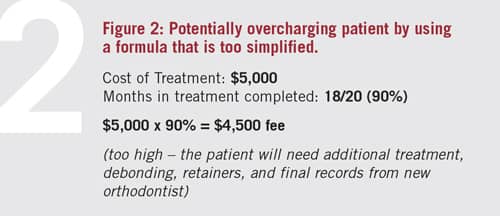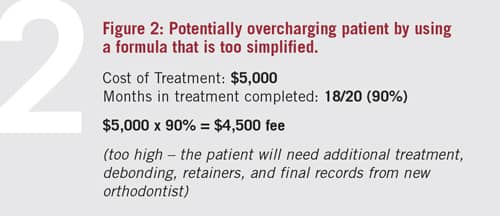Contents
You’re frustrated with your current orthodontist and considering switching, but you’re worried about the potential costs involved. Look no further – “How to Calculate the Cost of Changing Orthodontists” is here to help! This comprehensive guide breaks down all the factors you need to consider when changing orthodontists, from consultation fees and treatment plans to potential insurance coverage and hidden costs. With this valuable resource, you can make an informed decision that fits your budget and ensures the best possible care for your orthodontic needs. Don’t let financial concerns hold you back from finding the perfect orthodontist – let us empower you with the knowledge to calculate the cost of switching and make the right choice for your smile.

Factors to Consider
When considering changing orthodontists, there are several important factors that you need to take into account. These factors will impact your decision-making process and ultimately determine the cost associated with changing orthodontists. By carefully evaluating each factor, you can make an informed decision and ensure that the transition to a new orthodontist is seamless and beneficial for your oral health.
Treatment Stage
The stage of your orthodontic treatment is a crucial factor to consider when contemplating a change in orthodontists. If you are in the early stages of treatment, the cost of switching orthodontists is generally lower, as there will be minimal adjustments required. On the other hand, if you are in the advanced stages of treatment, such as wearing braces or aligners, the cost of changing orthodontists may be higher due to potential treatment plan modifications and the need for new appliances.
Treatment Plan
Another important factor to consider is your current treatment plan. The complexity of your orthodontic treatment and the specific goals you are trying to achieve will impact the cost of changing orthodontists. A more intricate treatment plan may require additional appointments and adjustments, adding to the overall cost. It is essential to discuss your treatment plan with potential new orthodontists to ensure they are capable of continuing your treatment effectively.
Type of Orthodontic Treatment
The type of orthodontic treatment you are receiving will also affect the cost of changing orthodontists. Different treatments, such as traditional metal braces, ceramic braces, or clear aligners, come with varying costs and different requirements for adjustments. Depending on the type of treatment you are currently receiving and considering switching to, there may be differences in price due to the materials and techniques used.
Geographical Location
Geographical location plays a significant role in determining the cost of changing orthodontists. Orthodontic fees can vary greatly depending on the area you reside in. Metropolitan areas tend to have higher costs due to higher living expenses, while rural areas may have lower orthodontic fees. When researching new orthodontists, it is essential to consider the cost of living in their respective locations to get an accurate understanding of the potential costs involved.
Orthodontist’s Reputation
The reputation of the orthodontist you are considering is a crucial factor in determining the cost of changing orthodontists. Orthodontists with a stellar reputation and years of experience may charge higher fees for their services. However, their expertise and track record of successful treatments can provide added peace of mind and potentially superior results. It is important to strike a balance between reputation and cost to ensure you receive the best possible care within your budget.
Insurance Coverage
Insurance coverage is a significant factor when calculating the cost of changing orthodontists. Review your current insurance policy and determine if changing orthodontists will affect your coverage. Different orthodontists may have different agreements with insurance providers, and it is essential to confirm that your insurance will still cover a portion of your treatment costs with the new orthodontist. Understanding your insurance coverage will help you make an informed decision and avoid unexpected out-of-pocket expenses.
Calculating the Cost of Changing Orthodontists
Once you have assessed the various factors involved in changing orthodontists, you can proceed to calculate the actual cost of the transition. By following these steps, you can gain a clear understanding of the financial implications and make an informed decision.
Reviewing Current Treatment Costs
Start by reviewing your current orthodontic treatment costs. Take into account any fees you have already paid, as well as the remaining balance. This will serve as your baseline for comparing costs with potential new orthodontists.
Researching New Orthodontists
Research different orthodontists in your area who are accepting new patients. Consider their qualifications, experience, and patient reviews to ensure they meet your expectations and requirements. Obtaining multiple quotes from different orthodontists will allow you to compare their fees and determine the potential cost of changing orthodontists.
Inquiring about Transfer Costs
Contact the new orthodontists you are considering and inquire about any transfer costs involved. Sometimes, there may be administrative fees associated with transferring your records and treatment plan to a new orthodontist. Factor in these additional costs when assessing the affordability of changing orthodontists.
Confirming Insurance Coverage
Once you have narrowed down your options, contact your insurance provider to confirm the coverage with the potential new orthodontists. Ask whether your insurance policy will cover the same percentage or amount of treatment costs with the new orthodontist. This will help you assess the financial impact of changing orthodontists based on your insurance coverage.
Considering Additional Expenses
In addition to the direct costs of changing orthodontists, it is important to consider any potential additional expenses. These may include travel expenses if the new orthodontist is further away, time off work for appointments, or any additional procedures or treatments that may be necessary due to the change in orthodontists. By factoring in these potential costs, you can make a more accurate assessment of the overall cost of changing orthodontists.

Paying for the Change
After considering the cost of changing orthodontists, it is necessary to explore various payment options to ensure a smooth transition without financial strain. Here are some options you can consider:
Out-of-Pocket Payments
If you have the financial means, paying for the change out-of-pocket may be the most straightforward option. This allows you to avoid additional interest or fees from financing options and gives you more control over your payments.
Financing Options
Many orthodontic practices offer financing options to help manage the cost of treatment. These options may include low-interest payment plans or third-party financing options. When considering financing, be sure to review the terms and conditions carefully to understand any potential fees or interest rates involved.
Utilizing Insurance Benefits
Maximizing your insurance benefits is another viable option to help cover the cost of changing orthodontists. Speak with your insurance provider to ensure you are taking full advantage of the coverage available to you. By utilizing your insurance benefits effectively, you can reduce your out-of-pocket expenses and make the transition more affordable.
Discussing Financial Arrangements with New Orthodontist
Finally, discuss your financial situation and concerns with the new orthodontist. They may be able to offer customized financial arrangements or options to help accommodate your budget. Open communication about your financial needs is crucial in ensuring a smooth transition without financial stress.

Other Considerations
Beyond the financial aspects, there are several other important considerations when changing orthodontists. These considerations can significantly impact your overall experience and the success of your orthodontic treatment.
Time and Effort
Changing orthodontists requires time and effort on your part. Researching and finding a new orthodontist, transferring records, and adjusting to a new treatment plan all take time and require your active participation. Consider whether you are willing to invest the necessary time and effort for a smooth transition.
Quality of Care
The quality of care provided by your new orthodontist should be a top priority. Research their reputation, read patient reviews, and assess their qualifications to ensure they meet your expectations. Remember, the goal is to receive the best possible care and achieve your desired outcome, so choose an orthodontist who can provide that level of quality.
Patient’s Comfort and Trust
Comfort and trust are essential in any healthcare relationship. Ensure you feel comfortable with your new orthodontist and trust their expertise. A positive and trusting relationship will contribute to a smoother transition and overall satisfaction with your orthodontic treatment.
Post-treatment Maintenance
Consider how the change in orthodontists may impact post-treatment maintenance and follow-up care. Communicate with the new orthodontist about their post-treatment protocols and what will be expected of you after the treatment is complete. Understanding the ongoing care required will help you make an informed decision and avoid any surprises down the road.
In conclusion, changing orthodontists involves careful consideration of various factors, including the treatment stage, treatment plan, type of treatment, geographical location, orthodontist’s reputation, and insurance coverage. By evaluating these factors and calculating the cost associated with changing orthodontists, you can make an informed decision that suits your financial situation and overall oral health needs. Additionally, exploring different payment options and considering other important factors such as time, quality of care, comfort, and post-treatment maintenance will contribute to a smooth transition and successful orthodontic treatment. Remember to consult with your current and potential new orthodontists to ensure a seamless and beneficial transition.












